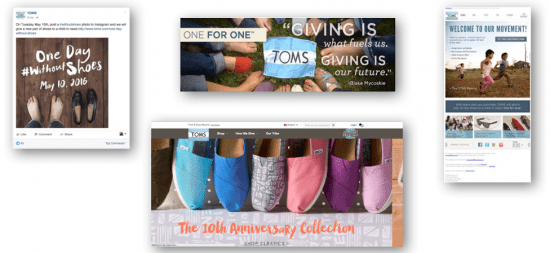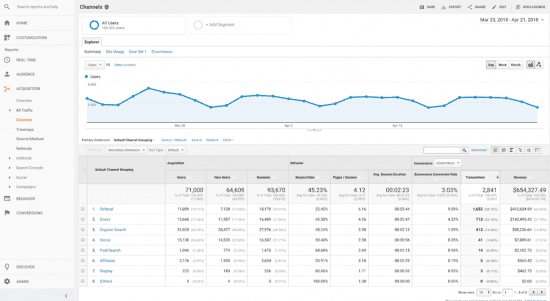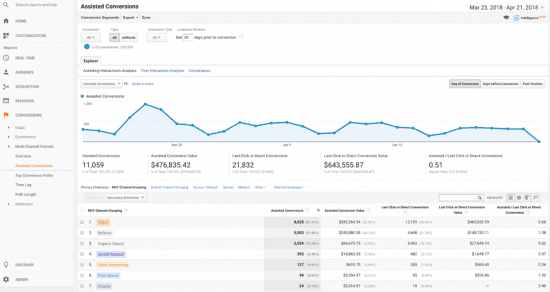Your marketing's most valuable player: using attribution.
Imagine a typical customer journey for a business like TOMS, a shoe retailer that sells online. A user sees a sponsored Facebook post that was liked by a friend about TOMS, and clicks through to Tom's site, browses for a while, then leaves.
Later on, the user sees a display ad from a TOMS retargeting campaign, and clicks through again, this time signing up for email alerts from the brand, but still not buying anything. Finally, the user receives an email from TOMS, clicks through, and starts to really think about buying the shoes. They leave it for a bit, and decide to buy, and they type the web address directly in the browser.

Who gets the credit for any revenue created? Well, that will depend on your attribution model. Attribution may sound complicated but in simple terms, it comes down to who gets the credit for your conversions and goals.
Did you know that the Acquisition report in Google Analytics uses 1 of 7 available attribution models?

All the reports north of Multi-Channel Funnels are locked into 1 of 7 Google Analytics attribution models, which is Last Non-Direct Channel.
This means that when you look at your Acquisition > All Traffic > Channels report, 100 % of the credit will go to the last non-direct channel.
In our TOMS example, that means that Email would get 100% of the credit for the sale.
Now knowing this, do you sack off the other marketing channels? They may look like they are not very good, that paid social campaign for example could have a big fat ZERO GOALS next to it, because in that user journey, it was the channel that got them interested, it was the channel that exposed them to the brand.
Let me ask you another question. Would you assign your budget differently if, say the Acquisition report was fuelled by the First Interaction Model?
Why should you care about Attribution Models?
Knowing what the attribution models are and how they work is really important.
The danger here is that people look at the reports in GA and only see everything through where the 100% of the credit goes.
It ignores the channels that may be exposing and supporting the customer through their journey to purchase, and only rewards the channel that gets your customer across the goal line and converts them.
So what can you do about it?
Balance the score card. By this I mean give a better, more honest and balanced view on how your marketing channels are working for you.
In the latest Quick Win for Smart Insights members, I go through the following points:
- We will walk through how the Acquisition reports in Google Analytics actually work when it comes to assigning credit
- How the Multi-Channel Funnels reports can improve your understanding of how well your marketing channels are working to drive conversions, and their role (e.g. do they assist or close the deal)
- The different types of attribution models there are within Google Analytics
- How to create your own attribution model
Media attribution analysis and modelling in Google Analytics
This Quick Win explains attribution and the business need for it; reviews different alternative channel attribution models; shows where to find the reports in Google Analytics and how to interpret them and gives practical steps for applying attribution.
Access the quick win
However, if you want to have a sneak peek and idea of what the process is, you can follow these 3 steps to get started.
Step 1: Start by reporting on your marketing channels using the Acquisition Report. BUT make a note to people that this is giving conversion credit to the last non-direct channel.

Step 2: Show how the channels worked in Assisting conversions. You will find this report under Conversions > Multi-Channel Funnels > Assisted Conversions. This report is going to show you which channels assisted in getting those goals!

Just to boggle your mind (a little bit) the Multi-Channel Funnels report is running on a different reporting API than the Acquisition reports that we just talked about. The key difference is how they treat Direct traffic. In the acquisition channels report, it is the last Non-Direct channel to get 100% of the credit, comparatively, in the Multi-Channel Funnel reports - it works on Last Click, so if Direct was the last touchpoint then Direct would get 100% of the credit.
You do have the option to toggle between the MCF Channel Grouping and the Default Channel grouping in the report.

Step 3: Have a look at the Attribution Model comparison tool found in Conversions > Multi-Channel Funnels > Attribution > Model Comparison. Here you can see what the conversions look like when you move between the 7 attribution models in GA, which are listed below. You can play around here with different models, BUT you cannot change the fact that the reports north of MCF Channel Groupings default to the Last Non-Direct Click.
- Last Interaction
- First Interaction
- Linear
- Time Decay
- Position Based
- Last Non-Direct Interaction
- Last AdWords Click
- Last interaction attribution model (popularly known as last touch attribution model): This model assigns 100% credit to the last interactions. Google Analytics uses this model by default.

- First interaction attribution model (popularly known as First touch attribution model): This model assigns 100% credit to the first interactions.

- Linear attribution model: This model assigns equal credit to each interaction in a conversion path.

- Time Decay attribution model: This model assigns more credit to the interactions which are closest in time to the conversion.

- Position based attribution model: This model assigns weighted credit to the first interaction, middle interaction and last interaction.

- Last Non-Direct Click model: This model assigns all the credit for conversions to the last non-direct click in a conversion path.

- Last Adwords Click: This model assigns all the credit for conversions to the last Google AdWords click in a conversion path.



















